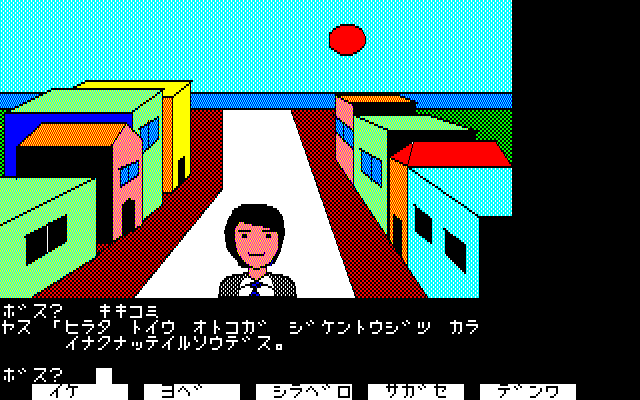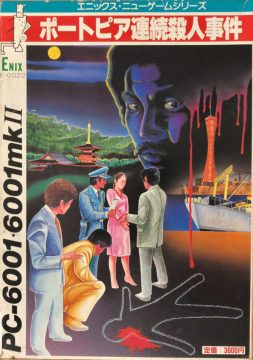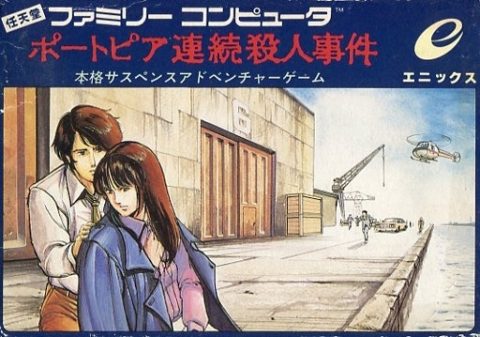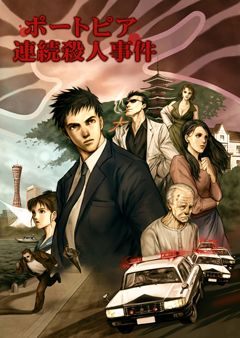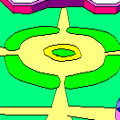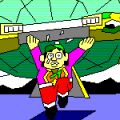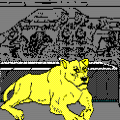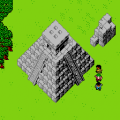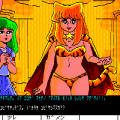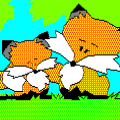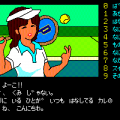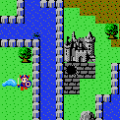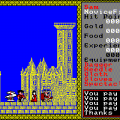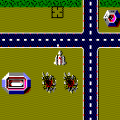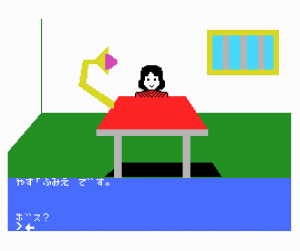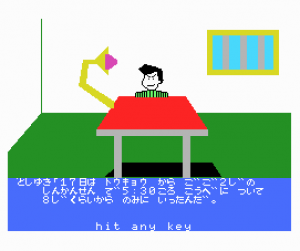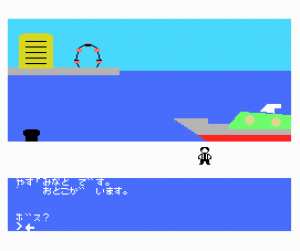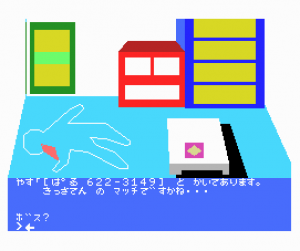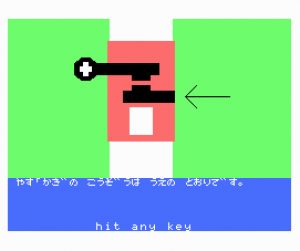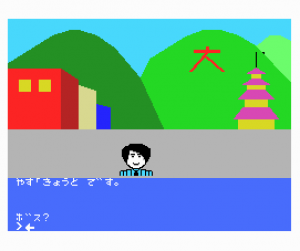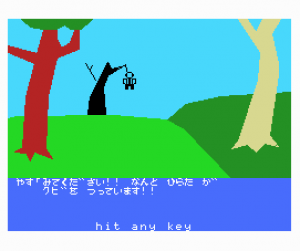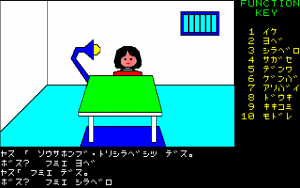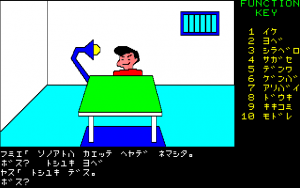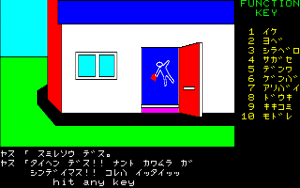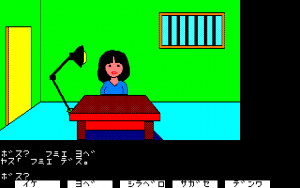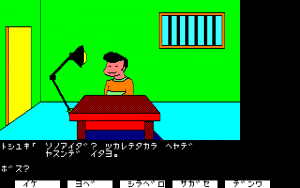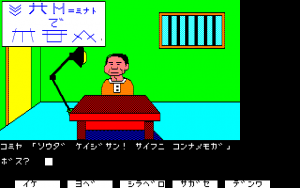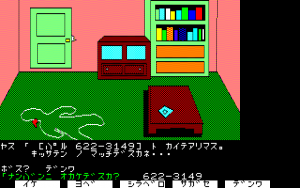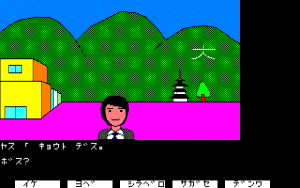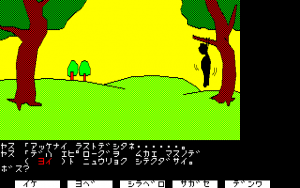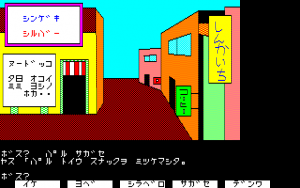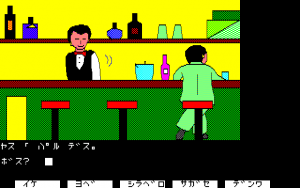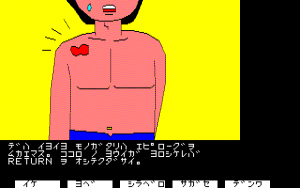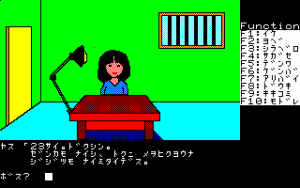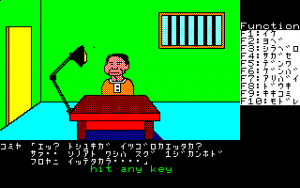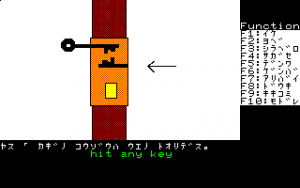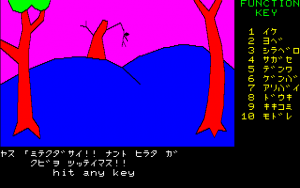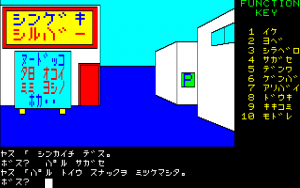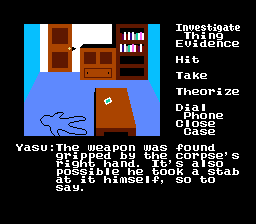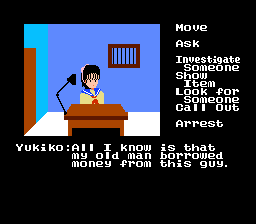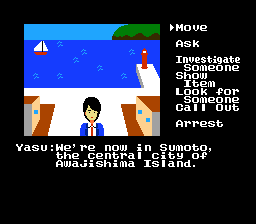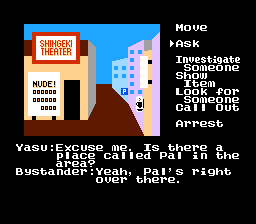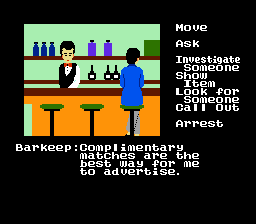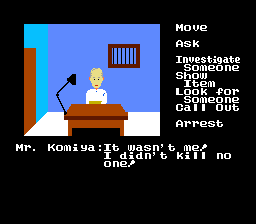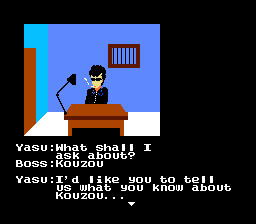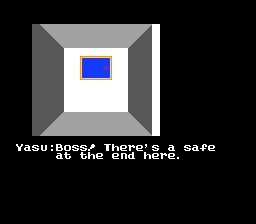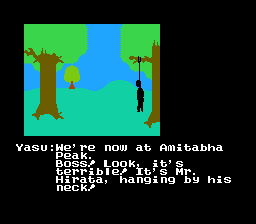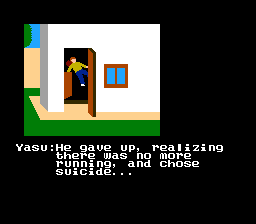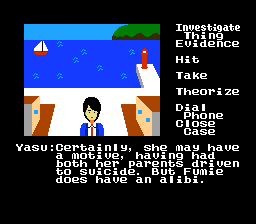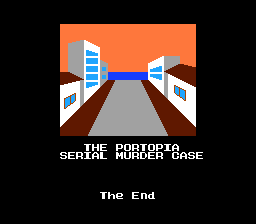- Portopia Renzoku Satsujin Jiken
- Hokkaido Rensa Satsujin: Ohotsuku ni Kiyu
- Karuizawa Yuukai Annai
In a cutscene at the end of Metal Gear Solid V, a game set in the 1980s, a man is loading a cassette tape in MSX computer and the characteristic loading noises from a data tape are played. It did not take fans long to find out that the audio contained the header of the 1983 Japanese adventure game The Portopia Serial Murder Case, a game Hideo Kojima famously has quoted as one of the reasons he went into the video game industry. In fact, this by modern standards rather primitive graphical text adventure is often heralded as one of the most influential games in Japanese video game history. Similar to how Sierra’s King’s Quest (1984) shaped the direction western computer adventure games would take, Portopia has been instrumental to the development of the adventure (ADV) genre, but also to Japanese video game interface design in general.
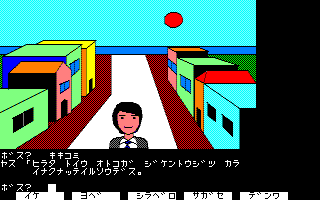
PC-8801
The game was developed by Yuuji Horii, the father of the Dragon Quest series. Directly prior to the first Dragon Quest (1986), Horii wrote three murder mystery adventure games that are collectively referred to as The Yuuji Horii Mysteries: Portopia Renzoku Satsujin Jiken (1983), Hokkaido Rensa Satsujin: Ohotsuku ni Kiyu (1984) and Karuizawa Yuukai Annai (1985). The three games are stand-alone titles, but share gameplay and design elements. Out of the three games, the first (Portopia) is the most known in the West, thanks to a fan translation of the Famicom port.
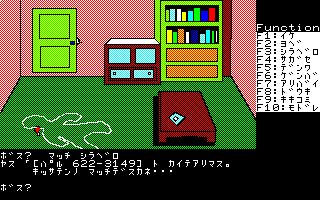
Sharp X1
The history of Portopia is in many ways also the history of Enix. From what Horii has told in different interviews over the years (cf. References and further reading below), the story goes that in 1982, Horii was a writer for a computer game column in Weekly Shounen Jump, and learned that a new game publisher named Enix had launched a competition (The 1st Game Hobby Program Contest) to find talented programmers whose games they could publish. Horii programmed and submitted a sports game called Love Match Tennis (ラブマッチテニス) for the NEC PC-6001 and it was selected as one of the thirteen winners that was published in February 1983 as the company’s debut product line-up. The 13 games ended up selling very well (a 300 million yen profit in the first year; Iwamoto, 2006) and established Enix as a major player in the industry. From here on, Horii would remain in game development. Influenced by e.g. a magazine ad for Infocom’s detective-themed text adventure Deadline (1982), Horii began toying with the idea of writing a game driven by typed conversations between the user and the computer. The grand ambition of developing a conversational AI for 80s microcomputers fell through in the end. The ideas, however, led to Portopia Renzoku Satsujin Jiken, released by Enix for the PC-6001 in June 1983 for their second batch of games, just a few months after Love Match Tennis.
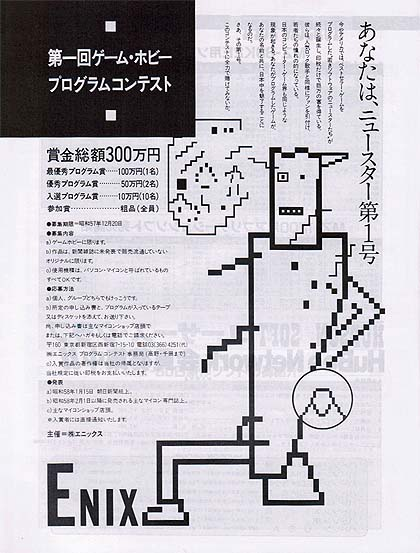
Flyer for the 1st Game Hobby Program Contest. The winner got a prize of 1 million yen, the second place 50,000 yen, and 10 additional winners 10,000 yen each. All prizes were in fact advance royalties (Andreyev, 2018)
Portopia is a murder mystery text adventure game with static illustrations, much like Roberta and Ken Williams’ Mystery House (1980). You play as an unnamed police detective referred to as “Boss” and investigate a number of murders in the Kobe area with the aid from your subordinate Yasuhiko “Yasu” Mano. The computer versions open with a title screen and the sound of gunshots and an ear-piercing police siren. A couple of text screens inform you of the background story: a moneylender named Kouzou has been found dead inside his locked study by two of his employees and you and Yasu are sent to investigate the suspected suicide. As the title implies, more murders will occur during the course of the game as you dig deeper into the plot.
The titular “Portopia” (a portmanteau of Port and Utopia) refers to the setting of the game: Portopia ‘81 was the name of a world expo held on the artificial island Port Island, Kobe in March-September 1981, and would probably still have been a recognizable name in 1983 when the game was made. While the idea of a murder mystery on the expo grounds is intriguing, you actually never visit Portopia in the game, and the closest you get to Port Island is a scenic view of the expo hotel and Ferris wheel from across the harbour. Instead, the game takes place in other real life locations in the Kobe region – an area which likely was highly familiar to Horii, as he was born in Awaiji Island.
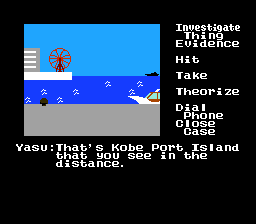
Famicom
In typical adventure game fashion, you visit different locations to collect clues to unwind the mystery. While being a fairly short game with only about 12 different locations and 10 characters depending on version, the game is very open-ended and you might need to stumble about to find what you need to do to proceed. It will soon become apparent that this is one of those old-school games that expect you to take pen-and-paper notes while playing. There is basically only one actual puzzle in the game (a cipher related to a subplot about Kouzou’s delinquent nephew), and instead the gameplay is structured around narrative progression. Finding information triggers new story flags, and is primarily done by investigating different locations, making phone calls and by calling people to the police station to interrogate them. To make things more interesting and put some more flesh on the proverbial story bone, there are quite a few subplots to look into (that more often than not turn out to be red herrings). Thankfully, there are no fail-states, which is a blessing seeing that there is no save or password feature. The lack of saving is less of a drawback than it first seems, since the open-ended design and short length of the game allow you to use your accumulated knowledge to quickly catch up to where you last were.
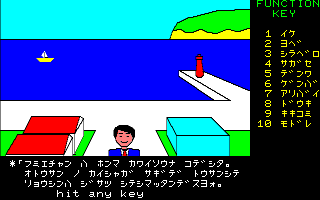
Sumoto, Awaiji Island (FM-7)
The microcomputer versions of Portopia are controlled by a text parser, and were one of the first Japanese text adventures to accept kana input with correct Japanese syntax order (noun + particle + verb). But unlike most other text adventure games where the commands are sent to an all-knowing computer that tells you if an action is permitted or not, in Portopia commands are sent to Yasu. Successful commands are typically followed by an affirmative (“I’ll do that, Boss”) before Yasu returns with a comment or a clue – this is perhaps a remnant of the conversational AI-idea? This strongly reinforces the notion that the player really is the police inspector and that the game world is viewed through their eyes. This is further strengthened by how the parser only allows verbs in imperative form. In English parser games, a command like PICK UP APPLE could for instance be interpreted either as “(I will) PICK UP APPLE” or “Computer, PICK UP APPLE!” and both are equally valid in terms of gameplay. In Japanese, however, present indicative and imperative conjugate differently. In Portopia, a few verbs will suffice to perform most of the situations in the game: get information (ききこみする, kikikomi suru), investigate (しらべる, shiraberu), ask (きく, kiku), seek person (さがす, sagasu), return [to police station] (もどる, modoru), summon [person to interrogation room] (よぶ, yobu) and threaten [someone] (おどす, odosu). However, none of these will be understood by Yasu, unless they are entered as imperatives, e.g. ききこみすろ (kikikomi suro), しらべろ (shirabero), きけ(kike), さがせ (sagase), and so on. Thus it is clear that the player character is not performing the action, but orders Yasu to do it. This is a small difference, but goes a long way to increase the immersion, and as such Portopia could possibly be argued to be a very early example of a diegetic interface in video games. This gameplay device also returns in the spiritual sequel Okhotsk. In the third game in the series (Karuizawa), the verbs are in first person active (e.g. しらべる, shiraberu) to reinforce that the main character does all the actions himself.
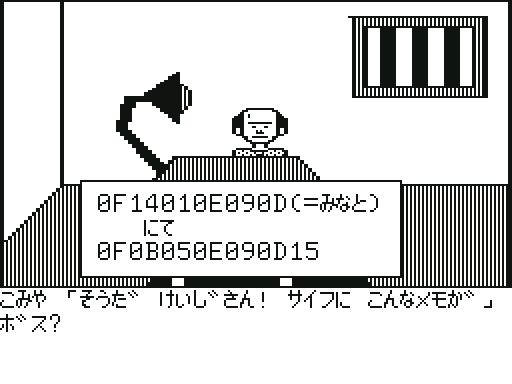
PC-6001 (monochrome mode)
The original releases of the game (PC-6001 and PC-8801) were a solo-effort from Horii himself. A number of ports for other microcomputer models soon followed suit, but were programmed by different people. Interestingly, each computer port features different ciphers for the code word needed to solve one of the subplots. Some of the cipher variants are easy to crack with a basic understanding of the kana syllabary, whereas others require you to know how to translate Hex code to kana, read sheet music, and to know which number of the syllabary that corresponds to each character. Other than this, there are only minor differences between the different computer versions. Each port has its own redrawn graphics, although all of them are crude, almost naïve looking. The PC8801 version features a lower-intensity mode where only the character sprites are drawn in full colour. The PC-6001mkII and port feature some voiced dialog (!) using the built-in voice synthesis, e.g. in the opening when Yasu greets you with “ohayou gozaimasu” (Good Morning). Some of the versions, e.g. the PC88, FM-7 and X-1 ones, feature hotkeys (F1, F2…) to quick-type some of the more common verbs.
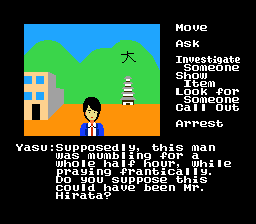
Famicom
As the Famicom grew in popularity, Enix began directing their focus to ports and development for this system, which sold at a much lower price than microcomputers but had comparable specs (Altice, 2015). In 1985, Horii, under the moniker Armor Project, joined up with programmer Koichi Nakamura of Chunsoft (with whom he would later develop Dragon Quest) to port the game to the Famicom. The biggest change from the previous versions is that it uses a verb selection menu instead of a parser, thus allowing a regular controller to be used for input (this system had already been used in the original computer version of the sequel Okhotsk which had been released the year prior, 1984). The game was designed for a standard Famicom cartridge without any expansion chips, and is regarded as an ingenious feat of programming, as Nakamura managed to cram in all the text from the original into such tight memory constraints (Altice, 2015), while also adding a graphical overhaul, a point-and-click interface (a magnifying glass and a hammer), a Wizardry-style first person maze, some new locations and one new character with her own subplot. This would turn out to be the most successful version of the game, selling an impressive 700,000 copies. In 1986, comedian Beat Takeshi (of Takeshi’s challenge fame) played the Famicom version live on his radio show All Night Nippon! and famously spoiled the twist ending by shouting “Hannin wa [N.N.]!” ([N.N.] is the culprit!). While this phrase is not present in the game’s dialogue, it has become an integral part of Portopia’s legacy, and a Japanese pop-culture meme.
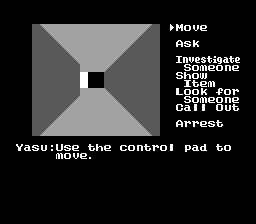
Famicom
In the 2000s, the three Yuuji Horii Mysteries saw two rounds of ports to different Japanese mobile formats. The first version came in 2003 for EZweb and Yahoo! Keitai and was called the Yuuji Horii Gekijou (theatre). A second version called Yuuji Horii Mysteries was released in 2005-2006 for the same formats and for i-mode. The Portopia port is based on the Famicom one i.e. includes the maze. Sadly, like most old mobile games, these ports are lost to time.
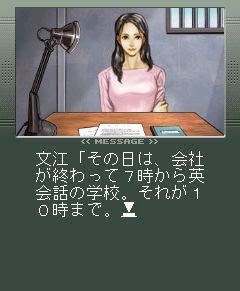
Mobile (2005)
Portopia is one of the earliest Japanese text adventure games, but not the first as it is sometimes given credit for; it was preceded by e.g. Omotesandou Adventure (April 1982) and MicroCabin’s unofficial Mystery House-knock-off Mystery House (1982). The reason why this particular game became formative for the genre can be attributed to a number of innovations. It features a modern (non-fantasy) world with an open-ended investigation style that, at least to a layman, feels like a realistic depiction of police work. The narrative-focused gameplay combined with Horii’s manga-inspired prose and visual aids build a believable and slightly eerie world that still, so many years later, and despite its primitive design, manages to draw players that are willing to invest time in this game, into its story. This primarily due to the ingenious decision to make Yasu a front-end for the computer terminal, which in turn make the player feel almost like they are playing the game together with Yasu. The narrative arguably flows better than in contemporary adventure games since Portopia omits the Zork-like stepwise cardinal direction movement and instead allows you go directly the locations of interest. And while the Japanese syntax parser was novel for the computer versions, the breakthrough hit of the Famicom port established verb selection menus in Japanese adventure games, to the degree that by the latter half of the eighties they were more or less extinct. All this taken together led to the game igniting a Japanese murder mystery video game craze, and many followers put “Satsujin Jiken” (Murder Case) in their titles to capitalize on Portopia. In fact, a few mystery fiction novelists were recruited to make their own Famicom series, such as the Nishimura Kyoutarou Mysteries and Yamamura Misa Suspense.
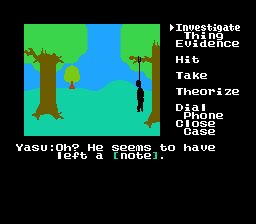
Famicom
There is no denying that Portopia Renzoku Satsujin Jiken is a primitive, naive looking, sparse, obtuse and challenging game – especially in the parser versions. It is also clear that it is a cornerstone of Japanese video game history and a game whose narrative holds up surprisingly well today, despite its simplicity and rough edges. The Famicom is the best place to start if you want to experience the game for yourself, thanks to its fan translation and verb selection interface.
Screenshot comparisons
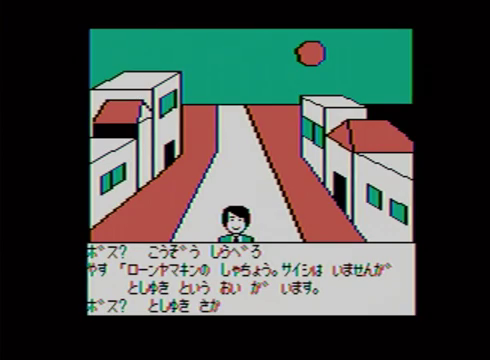
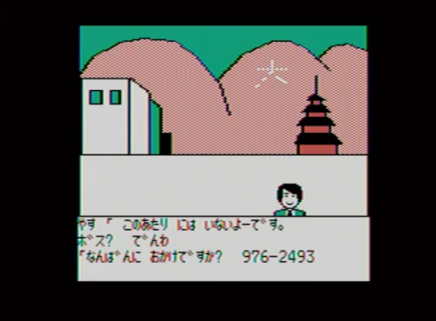
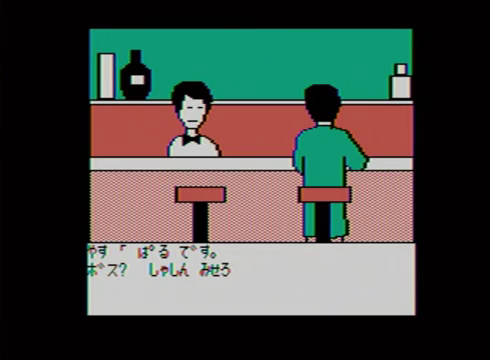
PC-6001/PC-6601 (here: 4-color mode on PC66)
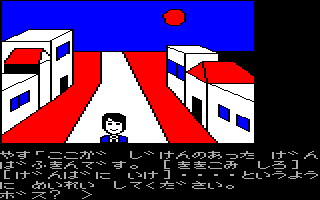
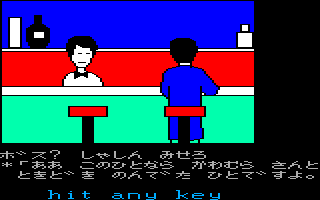
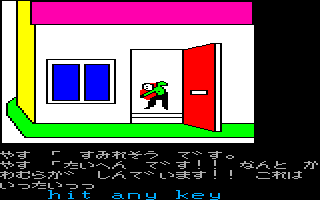
PC-6001mkII
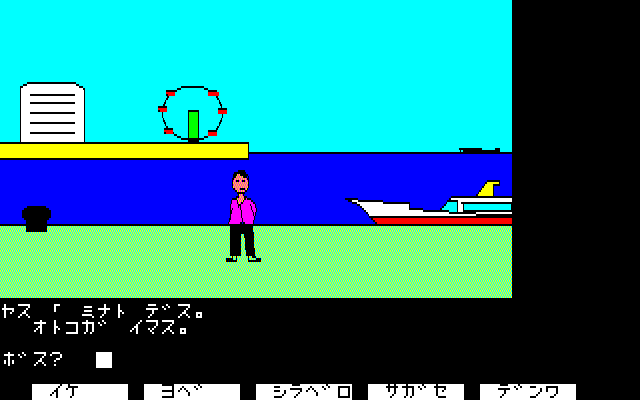
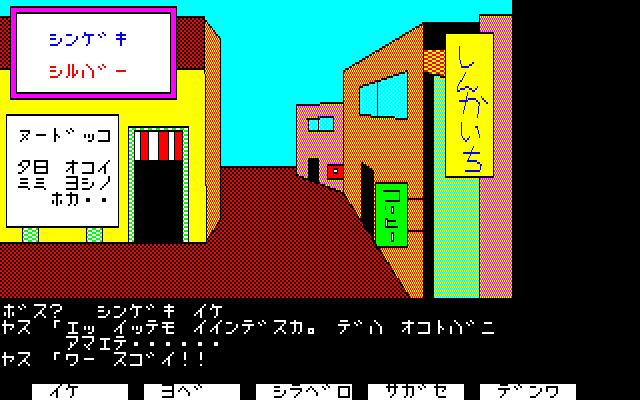
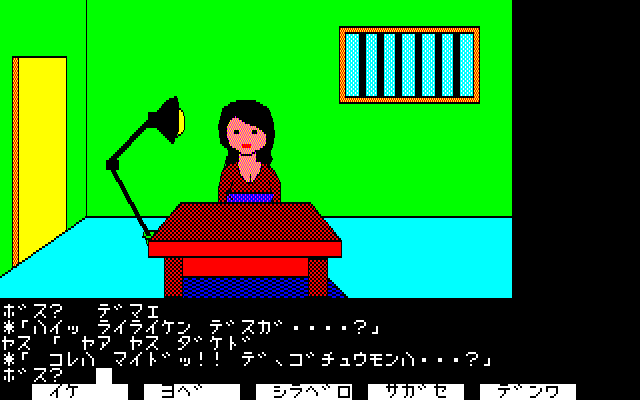
PC-8801
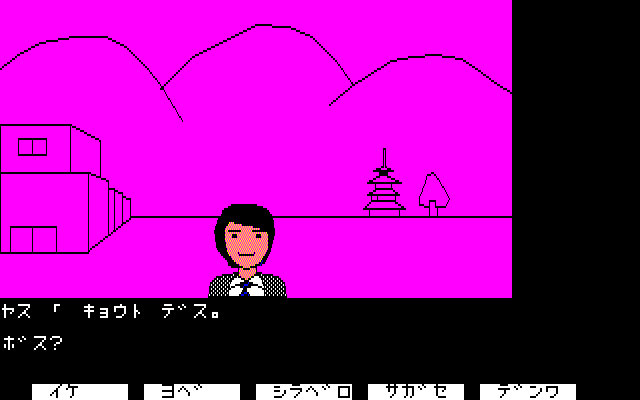
PC-8801 (low-color mode)
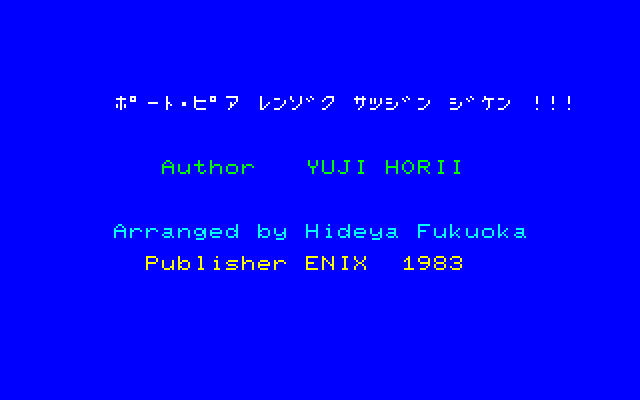
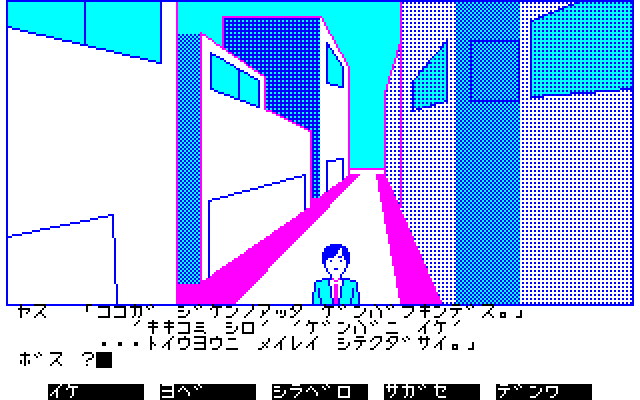
PC-8801mkII
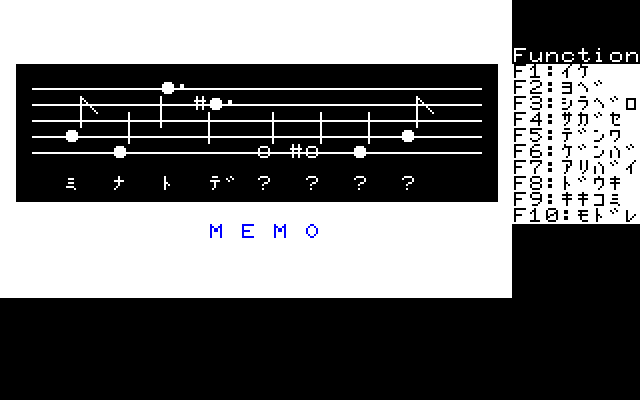
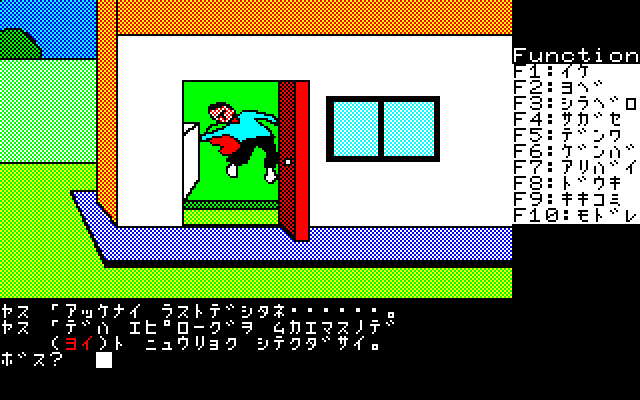
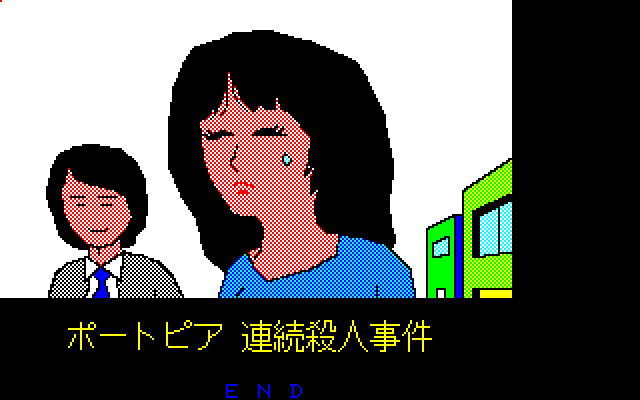
X1
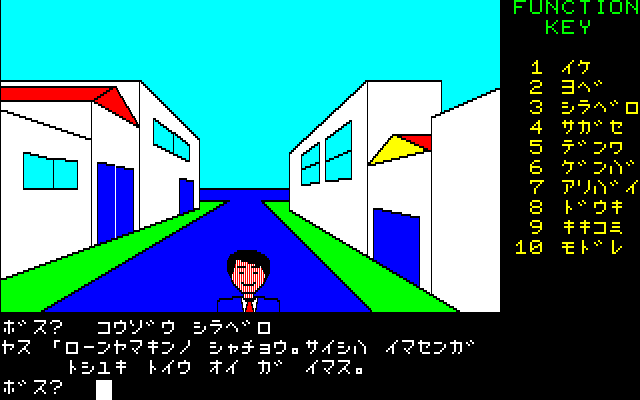
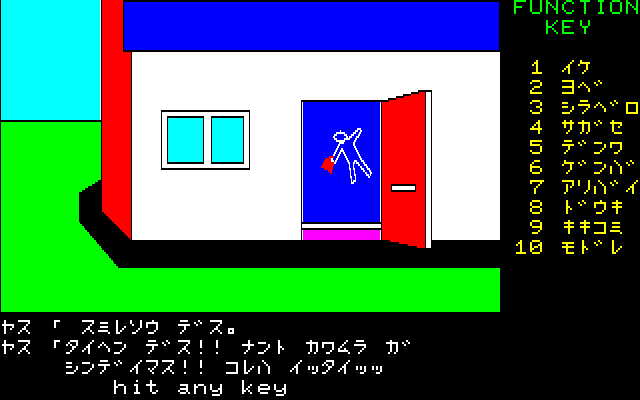
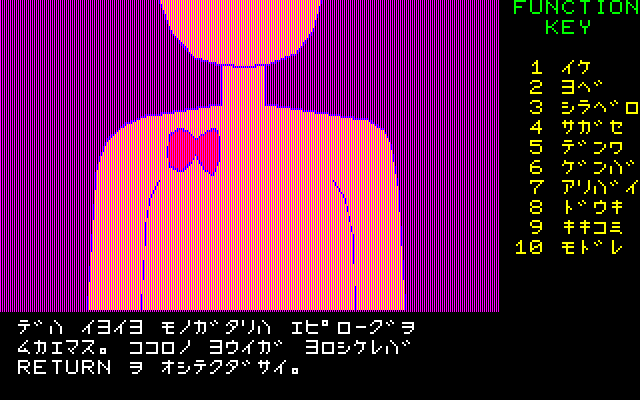
FM-7
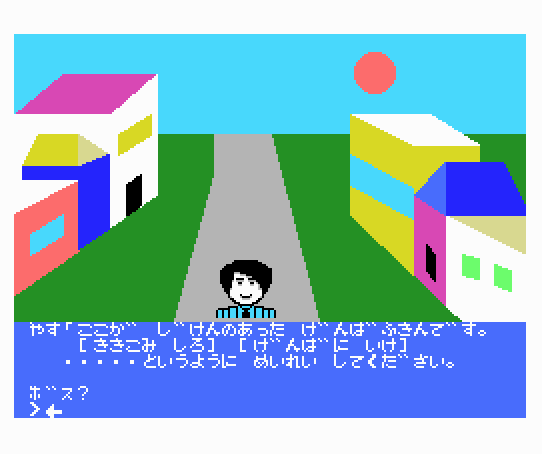
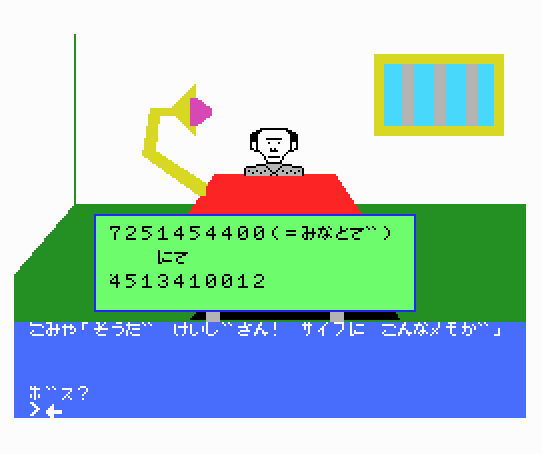
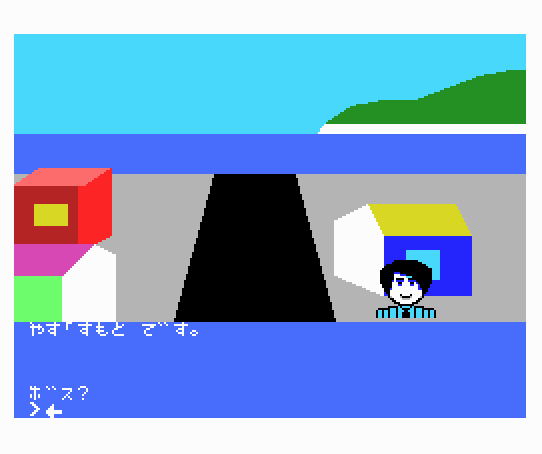
MSX
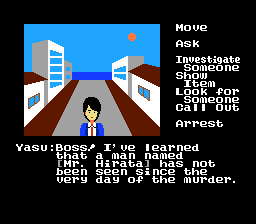
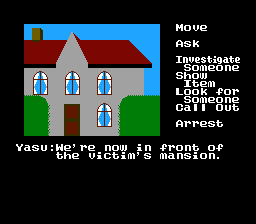
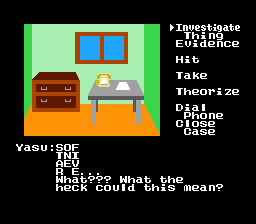
Famicom
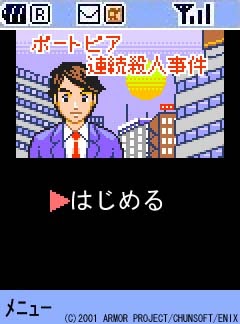
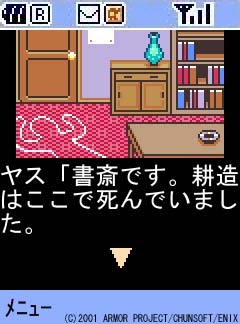
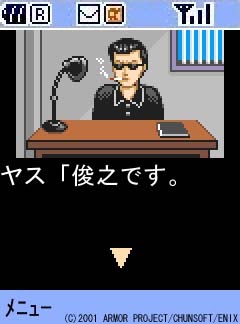
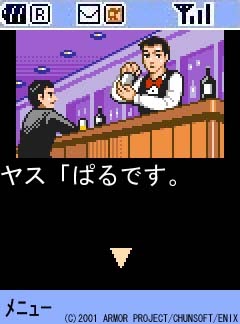
Mobile (2003)
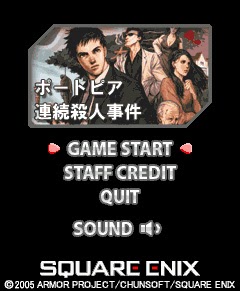
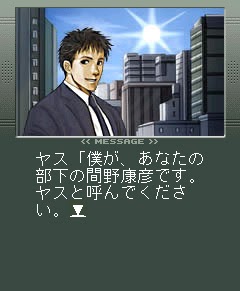
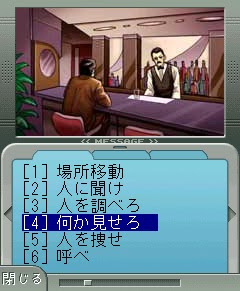
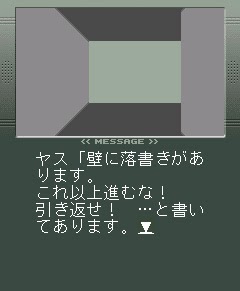
Mobile (2005)
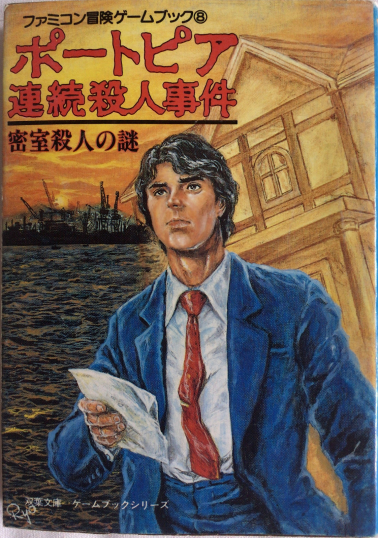
Famicom Adventure Game Book
References and further reading
Altice, N. (2015). I am error: The Nintendo family computer/entertainment system platform. MIT Press.
Andreyev, D. (2018), The Legend Of Dragon Quest, Third Editions.
Iwamoto, Y. (2006). Japan on the Upswing: Why the Bubble Burst and Japan’s Economic Renewal. Algora Publishing.
Previous HG101 texts on Portopia has also appeared in:
- Kalata, K. (2011), Hardcoregaming101.net Presents: The Guide to Classic Graphic Adventures, CreateSpace Independent Publishing Platform.
- Kalata, K. (2019), Hardcore Gaming 101 Presents: Japanese Video Game Obscurities, Unbound
Translated interview with Horii and Rika Suzuki of Riverhillsoft from BEEP magazine (1987) and transcript of the original Japanese version:
http://shmuplations.com/adventuregames/
Translated interview with Horii (and others) from the book Introduction to Game Design (1994):
http://shmuplations.com/1994game1/
Translated interview Chunsoft on the Portopia Famicom port (from Famitsu, 2014):
http://shmuplations.com/chunsoft30th/
Interview in Japanese with Horii in Automation (2017):
https://automaton-media.com/articles/interviewsjp/20171215-59185/
Short piece on Portopia written by Horii in 2007 (possibly as a promotion for the mobile ports):
A thorough account of the early years of Horii and Nakamura:
https://medium.com/@thomas25well/the-story-behind-dragon-quest-c914a7bd3d74
Dragon Quest e no Michi (“The Road to Dragon Quest”) manga which details the pre-Dragon Quest Enix era, including the 1st Hobby Competition and Portopia, is available on Archive.org:
https://archive.org/details/roadtodragonquestmanga
Horii on how they had to shave stuff off the game to fit the Famicom port in a standard cartridge:
https://www.glitterberri.com/developer-interviews/miyamoto-horii-discussion/
Video of the PC-6001mkII version in which the voice synthesis effect can be heard:
https://www.nicovideo.jp/watch/sm1020440
Site with information on the Portopia ‘81 fair and souvenir postcard showing the ferris wheel that is the only part of Portopia/Port Island actually visible in the game:
https://www.worldsfairphotos.com/portopia81/index.htm
https://www.worldsfairphotos.com/portopia81/images/postcards/set-4-17.jpg
Original sites for the 2003 and 2005 mobile ports:
https://web.archive.org/web/20011212084533/http://www.enix.co.jp/product/i-mode/mikaiketu.html
https://web.archive.org/web/20070125183159/http://www.square-enix.co.jp/mobile/game/mysteries/
